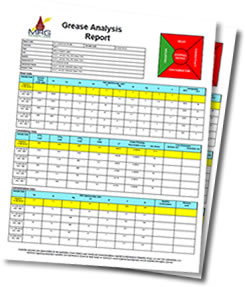Grease Analysis: Explanation of Tests
 STREAMLINED GREASE ANALYSIS The Grease Thief is optimized to streamline grease analysis in the laboratory. The grease is extracted from the Grease Thief under variable pressure and force conditions. The grease can then be compared to the baseline grease to trend changes in consistency. During this test, not only is consistency data gathered; the grease sample is simultaneously extruded onto a thin plastic substrate which is preparing the grease for subsequent analysis tests including RDE spectroscopy, FT-IR and RULER Analysis.
STREAMLINED GREASE ANALYSIS The Grease Thief is optimized to streamline grease analysis in the laboratory. The grease is extracted from the Grease Thief under variable pressure and force conditions. The grease can then be compared to the baseline grease to trend changes in consistency. During this test, not only is consistency data gathered; the grease sample is simultaneously extruded onto a thin plastic substrate which is preparing the grease for subsequent analysis tests including RDE spectroscopy, FT-IR and RULER Analysis.
The lab has three standard test slates: Basic, Advanced and Root Cause Analysis.
Up to seven laboratory tests can be performed using approximately one gram of grease (one full Grease Thief) to determine wear, consistency, contamination and consistency.
Wear – Wear Testing detects the amount of ferrous debris and other wear metals in the grease. The FerroQ ferrous debris analyzer, RDE Spectroscopy, and analytical ferrography are used to evaluate wear.
Consistency – Using the Grease Thief the grease is extruded through a specially designed extrusion die to evaluate changes in consistency as compared to the baseline grease. This test tells us whether the grease has hardened, softened or dried out but also simultaneously it is preparing the sample on a thin plastic substrate for subsequent analysis. Rheometer testing is also used in advanced analysis of consistency.
Contamination – FTIR and other spectrometric techniques are utilized to determine mixing of different greases. Mixing of grease can be determined by looking at thickener type and additives.
Oxidation – The onset of oxidation can be measured with several tests. Measuring the residual amount of anti-oxidants exiting from the bearing, it can be determined if the re-greasing interval is sufficient for the equipment. FT-IR can also be used to measure the progression of oxidation.
Grease Thief Die Extrusion Test
The consistency of grease is determined by measuring the load under varying speeds during the extraction of the grease through an orfice slot. This is done using a load cell to compress the grease from the Grease Thief onto a thin plastic substrate. The consistency of the grease is compared to the baseline grease to measure changes in consistency to determine thinning or thickening of the grease.
Grease Colorimetry Testing
Grease Colorimetry Testing utilizes a patent-pending method that includes a visible spectrometer, a light-path sample cell, and a thin-film grease substrate to gather a visible light (400 nm to 700 nm) spectral graph of the grease sample. This method can be used to validate observed appearance changes in greases, trend darkening due to aging or overheating, characterize dye formulations of new greases, and can even approximate the concentration of certain particulate contaminants, such as coal dust or other solids accumulating in the grease.
FT-IR
FT-IR is used to fingerprint the molecular bonds in the grease. A thin strip of grease is dropped into the beam of the FT-IR where a fingerprint is taken of the sample. Similarly this is done with the baseline grease. The two spectra are overlaid and the analyst looks for differences between the two. Often time oxidation and grease mixing are spotted through this methodology.
RDE Spectroscopy
In Atomic Emission Spectroscopy the grease is made into a liquid form using a fixed amount of grease with a grease solvent mixture. The grease is dissolved in vial and ran in the RDE. The spectrometer is useful is detecting certain wear particles such Iron and Babbitt particulate as well looking for certain additive elements that could point towards grease mixing. Comparing element levels to the original baseline, grease mixing and wear metals are easily seen.
RULER
RULER Technology works on the principle of linear sweep voltometry. A variable voltage is applied to the sample while the current flow is measured. The presence of anti-oxidants remaining in the sample are determined. This test is useful in determining the remaining useful life of the anti-oxidants in the sample. Also, this test can be used to monitor the residual anti-oxidant purging out of the bearing to determine if the re-greasing cycle is at the appropriate time.
FerroQ
The FerroQ is used as an overall monitoring device for wear concentration. This test uses the idea of the Hall Effect to determine the amount of ferromagnetic material present in the sample. This is used a general flagging device for the lab when wear levels are excessively high. Generally, when the sample is 5,000 ppm Iron or higher analytical ferrography is recommended.
Analytical Ferrography
Analytical Ferrography is used as an advanced test to determine the amount, shape, composition and wear severity of the particulate in the sample.
Rheometer
Rheometer Testing is used as an advanced test to examine the consistency of grease. Using the cone and plate rheometer normal force measurements can be used to determine oscillation stress, recoverable compliance and G1 values.
